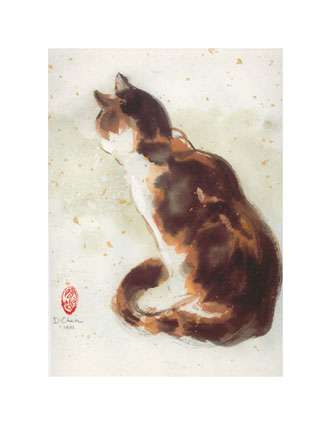FIP is without a doubt in my opinion, the most cruel of all the viral cat diseases. It is serious and fatal.
The virus that causes FIP is feline coronavirus (FcoV). In its benign form, the FcoV is called Feline Enteric Cononavirus (FECV). When FECV mutates, it becomes FIPV (Feline Infectious Peritonitis Virus). If the cat’s immune system is poor, the mutant FECV may cause the system infect (FIP).
The disease may appear to develop suddenly. But in fact, it develops so gradually and silently that the infection is well established before the symptoms appear. And when the symptoms become apparent, it is fatal.
FIP comes in 2 forms – effusive (wet) and noneffusive (dry). It is called wet because the blood vessels leak. In wet FIP, the most obvious sign is the swelling of the cat’s belly due to accumulation of fluid in the body cavity or the chest, around the lung area causing breathing difficulty.
Dry FIP has no build up of fluid but thick scar tissues develop on the cat’s internal organs. This can lead of diverse and complex clinical signs including neurological and ocular disorders, liver, kidney and intestinal diseases.
The wet form comprises of 60% - 70% of all FIP cases and has a more rapid progression than dry FIP. A cat with wet FIP usually dies within a month whereas a cat with dry FIP, it can live up a year. Cats that are susceptible to FIP are usually kittens and older cats.
The strength of a cat’s immune system response determines which form of the disease it develops. If the immune system reacts poorly, the cat will probably develop the wet form. A stronger response may result in the dry form. Kittens are prone to wet FIP (e.g. Fudge) and mature cats usually has dry FIP. However, the cat can carry the virus for several years without developing either form until its immune system weakens over time and develop the full-blown disease (as in the case of Dim Sum).
The common symptoms of FIP are persistent fever, poor appetite, weight loss, lethargy, anemic, low lymphocyte count (also common symptoms of FIV and FELV). The development of these typical clinical signs can only lead to suspicion of the disease. To this day, there are no tests that can diagnose a cat to be 100% FIP positive. However, when it is a wet FIP, vets can draw fluid samples from the chest or abdomen to do a test. In cases of FIP the fluid would show a high protein concentration. Drawing the fluid is of course, a very painful procedure for the cat. The only way to confirm a diagnosis is to do a post-mortem to examine the tissues.
There is no cure for FIP. Like all terminal illnesses, the basic course of action is to provide supportive care plus anti-viral drugs, antibiotics, good diet, lots of water.
FIP is contagious. Infected pregnant cats can pass the virus to the unborn kittens or via the milk to the newborns (that is how Fudge contracted FIP). The virus is spread through the infected cat’s hair, saliva but mainly stools. In a multiple cat household, it is advisable to separate the infected cat from the rest. My contention is, we don’t know a cat is infected with FIP until it becomes full-blown, so isn’t it a little too late to separate them? But vets will always tell you it is still better to do (it is their job after all).
At the end of day, the owner has to decide the best interests of the cats. In my case, I didn’t separate Fudge for a simple reason that she is a kitten and needs all the love and support from Dim Sum and Alex. But I am separating Dim Sum now simply because she wants to left alone. I have to respect her wishes.
Households with infected cat should make sure the floors, furniture, water & food bowls are properly washed and sterilised. Some books and sites recommend using clorox. But I just use the usual household anti-bacterial detergents.
In the early stages of detection, the cat can remain quite bright, it is like having a flu. But over time (a few weeks), there will be inevitable deterioration – jaundice, kidney failure, uncoordinated motor skills, blindness etc. But as long as the cat is not in obvious pain or discomfort, there is no need to put the cat down. But as the disease progresses, euthanasia may be the only option.


















